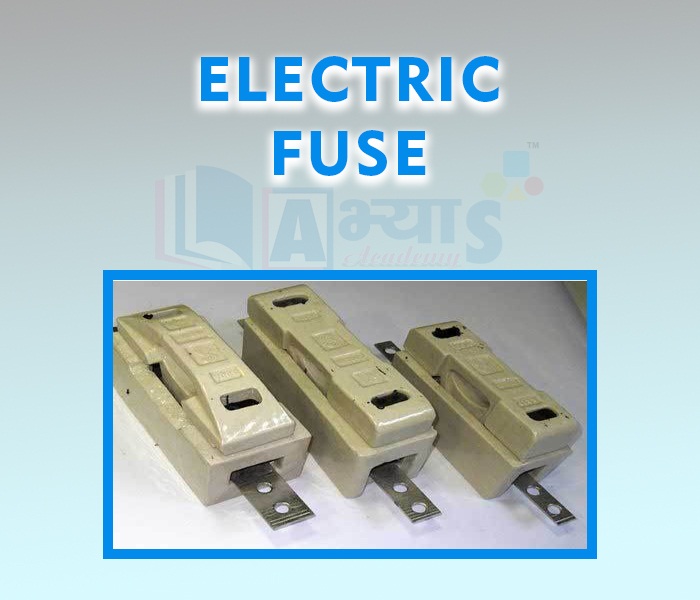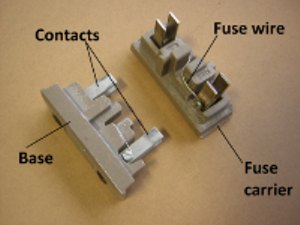Electric Fuse













Electric Fuse
|
Many electrical appliances are designed to work at a particular rated current. Passage of current greater than the rated current will damage the appliance. To prevent electric appliances from getting damaged from an excessive flow of current, a safety device called a fuse is used. A fuse is a safety device which is used to control the current in an electric circuit. It is connected in series with the mains supply. A fuse consists of an alloy of lead and tin which has appropriate melting point. Characteristics of a Fuse: It has a short length wire with a low melting point. The fuse wire is made an alloy containing equal amounts of lead and tin. It melts at about Principle of an Fuse: The electric fuse works on the principle of heating effect of current. The amount of heating caused depends on the amount of current. An electric fuse consists of a thin wire usually placed inside a glass or ceramic cartridge. The wire is made of a material that melts easily when heated. Working of a Fuse: A wire becomes heated when electric current passes through it. Wires made up of some special material that melts quickly and break when large electric currents are passed through them. Fuses of different kinds are used for different purposes. Different fuse wires can have different thickness. Thicker wires can withstand more electric current. There is a maximum limit on the current which can pass through an appliance or circuit. If by accident the current exceeds the limits, this excess current will pass through the fuse wire and melt it. Tthe circuit is broken. This will stop the passage of the current and the appliance is saved.
When the current flowing through the circuit exceeds the safe limit, the temperature of the fuse wire increases melts and breaks the circuit. It is required to rate the fuses for different current values such as 1 A, 2 A 5 A, 10 A, 15 A, etc. According to the devices used in the circuit we can calculate the amount of current that should allowed to flow through the circuit. A fuse with a rating little more than this value is used in series with the circuit to prevent the damaging of the devices. Fuses and Circuit Breakers: A fuse is a safety device that acts as a switch. Fuses are connected into the circuit close to the source. As a result all the current flowing in the circuit passes through the fuse. When too much current flows, the fuse heats up sufficiently to bum out. This creates an air gap and no more current flows. Illustration: An electrician puts a fuse of rating 5 A in that part of domestic electrical circuit in which an electric heater of rating 1.5 kW, happen in this case and why ? Solution: According to the question p=1.5 kW V = 220 V The current drawn by heater can be calculated using the formula
|
With which wire is the fuse wire connected? | |||
| Right Option : A | |||
| View Explanation | |||
Electric fuse is based on the principle of __________________ | |||
| Right Option : C | |||
| View Explanation | |||
Which of the following statements have no importance for fuse wire: 1. Specific resistance of wire 2. Diameter of wire 3. Length of wire 4. Current passing through the wire | |||
| Right Option : C | |||
| View Explanation | |||
Students / Parents Reviews [10]
It was good as the experience because as we had come here we had been improved in a such envirnment created here.Extra is taught which is beneficial for future.

Eshan Arora
8thMy experience with Abhyas academy is very good. I did not think that my every subject coming here will be so strong. The main thing is that the online tests had made me learn here more things.

Hiya Gupta
8thMy experience with Abhyas is very good. I have learnt many things here like vedic maths and reasoning also. Teachers here first take our doubts and then there are assignments to verify our weak points.

Shivam Rana
7thAbout Abhyas metholodology the teachers are very nice and hardworking toward students.The Centre Head Mrs Anu Sethi is also a brilliant teacher.Abhyas has taught me how to overcome problems and has always taken my doubts and suppoeted me.

Shreya Shrivastava
8thAbhyas Methodology is very good. It is based on according to student and each child manages accordingly to its properly. Methodology has improved the abilities of students to shine them in future.

Manish Kumar
10thA marvelous experience with Abhyas. I am glad to share that my ward has achieved more than enough at the Ambala ABHYAS centre. Years have passed on and more and more he has gained. May the centre flourish and develop day by day by the grace of God.

Archit Segal
7thAbhyas is a complete education Institute. Here extreme care is taken by teacher with the help of regular exam. Extra classes also conducted by the institute, if the student is weak.

Om Umang
10thBeing a parent, I saw my daughter improvement in her studies by seeing a good result in all day to day compititive exam TMO, NSO, IEO etc and as well as studies. I have got a fruitful result from my daughter.

Prisha Gupta
8thOne of the best institutes to develope a child interest in studies.Provides SST and English knowledge also unlike other institutes. Teachers are co operative and friendly online tests andPPT develope practical knowledge also.

Aman Kumar Shrivastava
10thI have spent a wonderful time in Abhyas academy. It has made my reasoning more apt, English more stronger and Maths an interesting subject for me. It has given me a habbit of self studying

